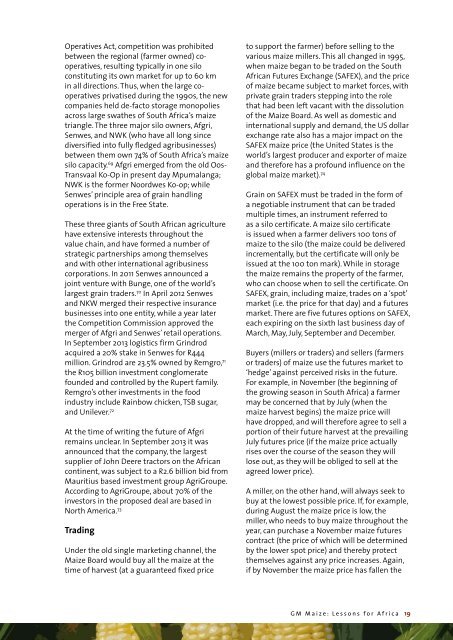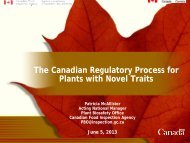GM-Maize-Report
GM-Maize-Report
GM-Maize-Report
You also want an ePaper? Increase the reach of your titles
YUMPU automatically turns print PDFs into web optimized ePapers that Google loves.
Operatives Act, competition was prohibitedbetween the regional (farmer owned) cooperatives,resulting typically in one siloconstituting its own market for up to 60 kmin all directions. Thus, when the large cooperativesprivatised during the 1990s, the newcompanies held de-facto storage monopoliesacross large swathes of South Africa’s maizetriangle. The three major silo owners, Afgri,Senwes, and NWK (who have all long sincediversified into fully fledged agribusinesses)between them own 74% of South Africa’s maizesilo capacity. 69 Afgri emerged from the old Oos-Transvaal Ko-Op in present day Mpumalanga;NWK is the former Noordwes Ko-op; whileSenwes’ principle area of grain handlingoperations is in the Free State.These three giants of South African agriculturehave extensive interests throughout thevalue chain, and have formed a number ofstrategic partnerships among themselvesand with other international agribusinesscorporations. In 2011 Senwes announced ajoint venture with Bunge, one of the world’slargest grain traders. 70 In April 2012 Senwesand NKW merged their respective insurancebusinesses into one entity, while a year laterthe Competition Commission approved themerger of Afgri and Senwes’ retail operations.In September 2013 logistics firm Grindrodacquired a 20% stake in Senwes for R444million. Grindrod are 23.5% owned by Remgro, 71the R105 billion investment conglomeratefounded and controlled by the Rupert family.Remgro’s other investments in the foodindustry include Rainbow chicken, TSB sugar,and Unilever. 72At the time of writing the future of Afgriremains unclear. In September 2013 it wasannounced that the company, the largestsupplier of John Deere tractors on the Africancontinent, was subject to a R2.6 billion bid fromMauritius based investment group AgriGroupe.According to AgriGroupe, about 70% of theinvestors in the proposed deal are based inNorth America. 73TradingUnder the old single marketing channel, the<strong>Maize</strong> Board would buy all the maize at thetime of harvest (at a guaranteed fixed priceto support the farmer) before selling to thevarious maize millers. This all changed in 1995,when maize began to be traded on the SouthAfrican Futures Exchange (SAFEX), and the priceof maize became subject to market forces, withprivate grain traders stepping into the rolethat had been left vacant with the dissolutionof the <strong>Maize</strong> Board. As well as domestic andinternational supply and demand, the US dollarexchange rate also has a major impact on theSAFEX maize price (the United States is theworld’s largest producer and exporter of maizeand therefore has a profound influence on theglobal maize market). 74Grain on SAFEX must be traded in the form ofa negotiable instrument that can be tradedmultiple times, an instrument referred toas a silo certificate. A maize silo certificateis issued when a farmer delivers 100 tons ofmaize to the silo (the maize could be deliveredincrementally, but the certificate will only beissued at the 100 ton mark). While in storagethe maize remains the property of the farmer,who can choose when to sell the certificate. OnSAFEX, grain, including maize, trades on a ‘spot’market (i.e. the price for that day) and a futuresmarket. There are five futures options on SAFEX,each expiring on the sixth last business day ofMarch, May, July, September and December.Buyers (millers or traders) and sellers (farmersor traders) of maize use the futures market to‘hedge’ against perceived risks in the future.For example, in November (the beginning ofthe growing season in South Africa) a farmermay be concerned that by July (when themaize harvest begins) the maize price willhave dropped, and will therefore agree to sell aportion of their future harvest at the prevailingJuly futures price (if the maize price actuallyrises over the course of the season they willlose out, as they will be obliged to sell at theagreed lower price).A miller, on the other hand, will always seek tobuy at the lowest possible price. If, for example,during August the maize price is low, themiller, who needs to buy maize throughout theyear, can purchase a November maize futurescontract (the price of which will be determinedby the lower spot price) and thereby protectthemselves against any price increases. Again,if by November the maize price has fallen the<strong>GM</strong> <strong>Maize</strong>: Lessons for Africa 19




